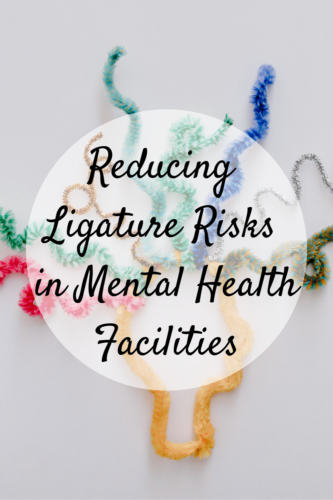
Managing a mental health facility requires continued attention to detail to protect the safety of residents, staff, and visitors. The potential for patients to self-harm is a crucial concern, requiring managers to choose streamlined furnishings and features to avoid problems. In addition, avoiding ligature risks is a top priority to reduce issues at your facility. Discover how to select items that reduce these risks to maintain the safest environment for treatment and healing.
What Does Ligature-Resistant Mean in Mental Health Facilities?
Ligature-resistant means the items have no areas where a bedsheet, fabric, cord, or other material could be tied to create an attachment that could lead to self-harm or death. When residents want to self-harm, finding a way to do so becomes compelling. Taking risks out of the environment helps to keep everyone protected against harm. As a result, management should be interested in ligature resistant furniture to create a conducive treatment environment.
Reducing Incidents of Self-Harm in Mental Health Care Facilities
Self-harm is a risk when running mental health care facilities because of certain patients’ conditions. Counseling and medication are common treatments used to treat mental health issues. However, it is also critical to establish an environment where patients have minimal opportunities to hurt themselves using necessities. For example, choosing ligature-resistant furniture eliminates the risk of self-harm using furniture and other essential items because there is nowhere to create an attachment or loop with fabric.
Focus on Suicide Prevention
Unfortunately, incidents of self-harm and suicide continue to rise at mental health hospitals, so careful thought must go into choosing furniture and components for these facilities. Features such as rounded edges are critical to reducing injuries in mental health facilities. For example, furniture should be constructed with handles that have no ligature fixation points. Examining furniture designs is a powerful way to reduce suicide attempts at your facility.
Investment in Safety
Purchasing updated furniture for your facility is an investment in the future safety of residents and visitors. Consider the cost of self-harm, treatment, and loss of life and their impact on your hospital’s reputation. Fitting ligature-resistant furniture into the budget is a necessary expense for optimal protection. Also, facilities can reduce the expense of constant supervision by selecting safe furniture and features to eliminate risks.
Risk Prevention Matters
Protecting patients from harmful behaviors is part of risk-prevention efforts at a mental health hospital. Teaching patients and providing treatment are crucial to their future success. As patients learn new behaviors, maintaining a safe environment reduces risks to help promote well-being. Ligature-resistant furniture is ideal in therapeutic settings to ensure patients can focus on their safety rather than acts of self-injury.
A Therapeutic Setting
Finally, establishing a therapeutic setting helps patients focus on their treatment and recovery. The right furnishings create a welcoming space where patients feel comfortable talking, unwinding, and starting healing. Streamlined designs without opportunities for self-injury eliminate distractions in a mental health facility, empowering patients to focus on treatment. Select safe designs in durable materials to keep patients focused on their recovery and at ease.
Ligature-resistant furniture is necessary for mental health facilities where there is a risk self-harm and suicide. Choose simple designs without points for attaching fabrics to reduce risks and empower patients and staff to focus on treatments rather than risk prevention. Reach out to a reputable furniture company today to discover more about the benefits of ligature-resistant pieces for your facility.





